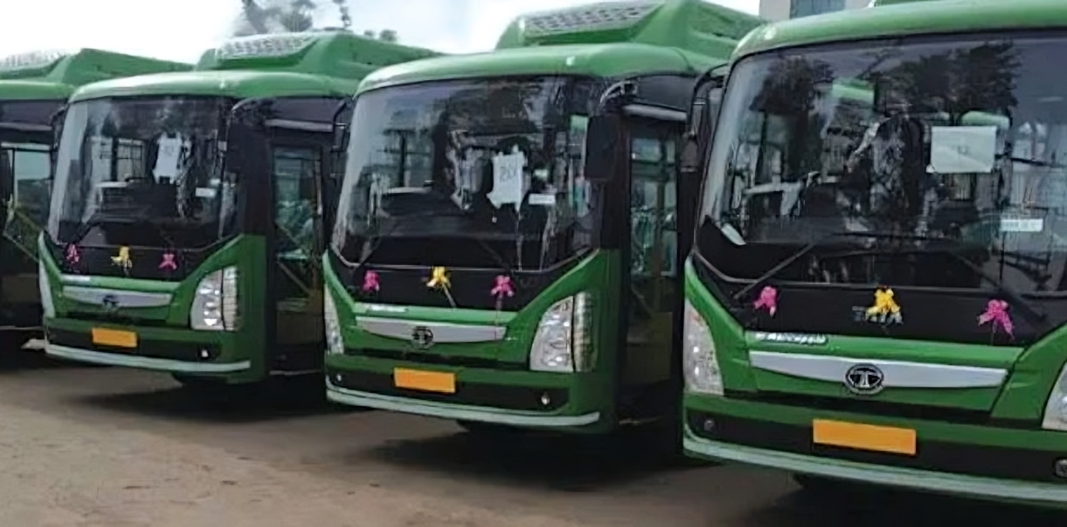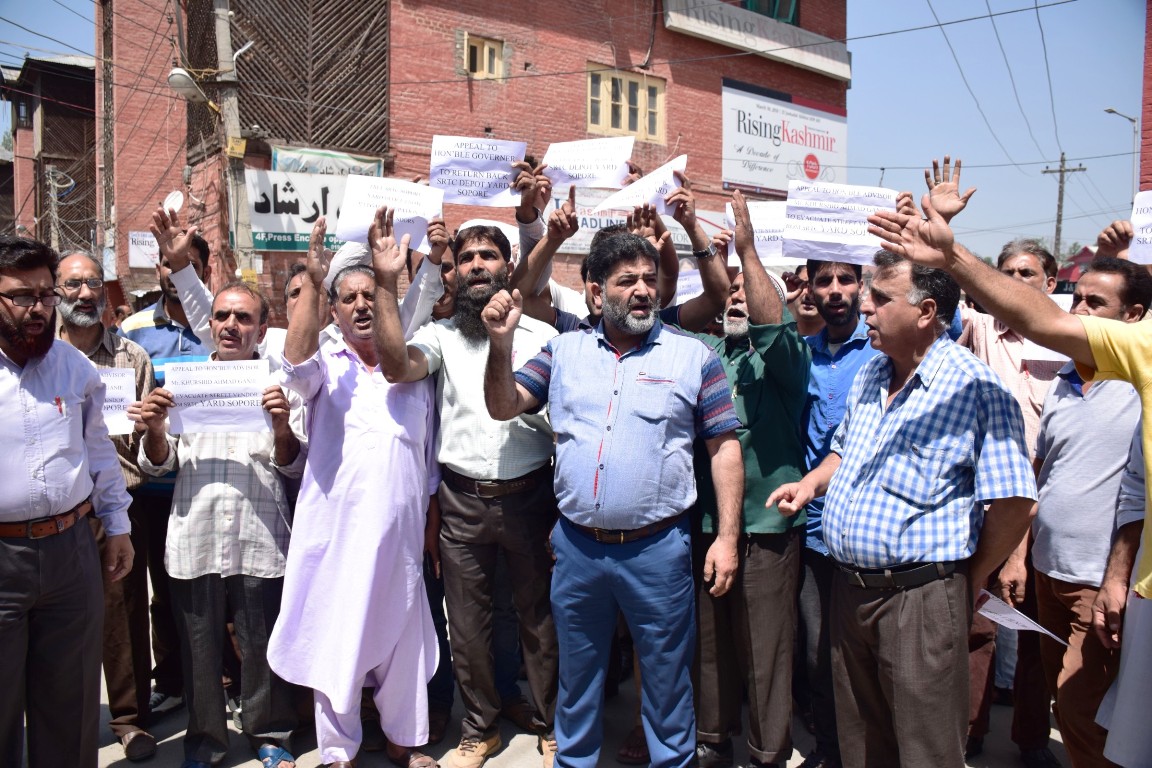Barely a few years after Jammu and Kashmir’s public transporter, the JKSRTC got a new fleet of trucks and buses, and the turnaround started. For fiscal 2023-24, the company anticipates Rs 200 crore turnover, a number that was once a utopian figure, reports Babra Wani

In 2019, the Jammu and Kashmir Road Transport Corporation (JKSRTC) unveiled a fleet of electronic buses, referred now as the “green buses”, in Kashmir. Then, the potential impact of these buses was not widely recognised. In 2023, this fleet has become a source of positive change for both commuters and the corporation.
These buses have emerged popular means of transport. “Since these buses started operating, many of our issues have been addressed,” a Chadoora resident, who now travels by RTC bus said. “The fare is economical, the buses are comfortable, and there is no need to wait for them to reach full capacity. They adhere to specific schedules.”
These buses have garnered commendation, particularly for their designated section for female passengers, enhancing convenience for commuters.
Out of about 40 buses for Jammu and Kashmir, twenty are operational in Srinagar. Currently, eighteen e-buses are in operation, while two are undergoing maintenance, as confirmed by a senior JKRTC officer.
While the commuters are happy, the corporation is also content with what it is doing – after a very long time. “The corporation had been grappling with outstanding debt, presenting a significant challenge,” an officer said. “However, there is now a noticeable improvement in the situation, with a reversal of the losses incurred.” The corporation hopes it will record a turnover of Rs 200 crore for fiscal 2023-24.
The Beginning
A senior company executive informed that the Ministry of Heavy Industries and Public Enterprises, a Government of India entity, introduced the Faster Adoption and Manufacturing of Hybrid and Electric Vehicles (FAME) scheme to address urban pollution caused by vehicles.
“The Government of India bore 60 per cent of the cost, under the scheme, with the remaining 40 per cent falling on the state government. In line with this, JKSRTC issued a tender in 2018 for the manufacturing of these buses by TATA Motors. The buses were commissioned and put into operation on the roads of Jammu and Srinagar in June 2019.”
This fleet is part of a Central Government initiative to mitigate pollution. “These buses are unique, representing a new venture even for TATA Motors, as the concept of electronic buses was unprecedented before their introduction,” he said. Before they were introduced in Jammu and Kashmir, the e-buses were already playing successfully in other states.
The Corporation management is taking extra care in ensuring these buses are not damaged. They have set up an in-house maintenance system. “We manage the maintenance of these buses ourselves,” the officer said. “Due to the high cost of spare parts, some exceeding a lakh of rupee, and the importation of certain components from foreign countries, these buses incur significant maintenance expenses. However, the buses currently undergoing maintenance will soon be back on the road.” On the flip side, however, these buses have “a finite shelf-life”.

Unlike private transport, the officer said the social commitments of the public transporter prevent it from becoming a profit-maker. “It is essentially a service. While our current earnings are satisfactory when considering the overall costs involved—such as driver and conductor salaries, and bus maintenance—we find ourselves unable to break even,” the officer said. “If you examine the bus fare, it is relatively low. Additionally, the distance covered is limited, leading to more losses. Furthermore, seats are reserved for students who pay only half of the regular fares, irrespective of their student status.”
The Fleet
The JKSRTC is one of the oldest public transporters in the region. In 1947, trucks and buses owned by companies such as ND Radhakrishnan, Allied Chirag Din & Sons, and Nanda Bus Service faced problems in a changed geo-political situation forcing the Jammu and Kashmir government to set up its transport utility. It formally started operations as Government Transport Undertaking (GTU) on January 5, 1948, with 50 trucks procured from M/S General Motor Corporation, Bombay. The GTU, founded on January 5, 1948, transformed into a corporation on September 1, 1976.
Throughout its history, the JKSRTC has remained part of the politics, folklore and communication of Jammu and Kashmir. It is the one that would drive people out of Kashmir. It has been part of all wars and skirmishes in the region. In militancy, it lost nearly 120 buses and trucks simply because a militant outfit was opposing the telecast of the Doordarshan tele-serial Bible Ki Kahaniyan. Then it reached a stage where it lacked resources to feed its staff forcing the government to give it a lease of life – budgetary support – Rs 30 crore a year. It gave up routes and opportunities that gradually the private transport took, inch by inch.
“We were getting Rs 7.5 crore of budgetary support every quarter that would usually go into managing the chronic debts we had,” the officer said. “Last year we got it once a year but, somehow, we managed our requirements. Our salaries are on time and our liabilities have reduced significantly.”
Right now, the JKSRTC has an overall fleet of 110 vehicles including trucks. It includes only 40 e-buses, rest are diesel-fuelled. The overall bus fleet is slightly more than 200. “In Kashmir, we have 130 buses operational on district routes, 55 operate on national highway; in Jammu, there are 60 buses managing the inter-state network, 45 are dedicated to district routes,” the officer said. “Srinagar city has 20 buses and Jammu city has 16 operational buses right now.”
The Mandate
Public transporters have commitments as they do not operate for mere profit. It provides affordable and punctual transportation services to commuters and adheres to strict schedules.
“Losses are inherent in various fleets, but we maintain diversified fleets,” the officer said. “In instances where losses occur in one sector, we strive to offset them by generating profits from other sectors.”
“Last year, we had a revenue of Rs 150 crore and this year, we have surpassed Rs 183 crore and we hope we will get Rs 200 crore turnover by March 2024,” the officer said. “But it is also important to note that our revenue comes better from our trucks and not buses. All public transport buses across India are not a profitable operation.”
The corporation’s load division is vital for the state’s public distribution system, especially in remote areas like Gurez, Tangdar, Machil, Keran, Leh, Kargil, Nobra, Zanskar, etc. Besides, the corporation provides carriage to various government departments and agencies, including the Department of Consumer Affairs and Public Distribution, the Food Corporation of India, the Army, the BSF, Beacon, SICOP and others.
“As long as the wheels are in motion, there are better earnings,” he said. “Our services catering to longer routes, exceeding two hundred kilometres, are more profitable compared to city routes, where distances are shorter, and traffic congestion limits profitability.” Corporation’s revenue would have been better had they not a role in city transport systems.
An Evolving Sector
Public transport is a fast-evolving sector, the world over. Earlier, all the buses in India were truck platforms (remember the KMDA buses). It took years to introduce buses which are meant to be buses. With newer technologies, buses have become impressive pieces of comfort.
“Previously, it was fuel and now it is fuel cell, a shift from diesel tanks to batteries. The buses are entirely electronic,” the officer said. “About two years ago, during severe winter conditions with temperatures dropping below freezing, a vehicle that usually takes two to three hours to charge took more than four hours. We filed a complaint, and TATA sent a team to upgrade their software based on our feedback.” Still, climatic conditions are a huge challenge to these technologies.
The comfort comes at a cost. An e-bus costs around Rs 1.25 crore, while a diesel-run bus is ready at almost Rs 30 lakh, a five-time investment. In diesel buses, there are 50 seats and e-buses have only 32.
Running the modern fleet requires creating new infrastructure. Inspected by the government-run CIRT, these buses have strategically placed charging stations in Bemina and Lal Chowk. After covering 120 km, buses require recharge. Maintenance is handled at the exclusive workshop in Bemina managed by JKSRTC.
“While it is five times expensive, we have to maintain the cheap fares,” he asked. “We have proposed to auction almost 237 buses this year and we have also initiated the process to procure more vehicles.” Still, we ferry nearly 40 lakh passengers a year. However, the corporation saved a bit by hiring conductors and drivers on a contractual basis.
The Revival
Top corporation executives credit their Managing Director, Rakesh Kumar Srangal for the turnaround. With over two years of tenure, Srangal introduced a straightforward roadmap that proved instrumental in transforming the financial standing of JKSRTC.
“Thanks to his policy-making and hard work, we have seen significant improvement,” an executive said. “Our terminal liabilities have reduced, and we are projected to earn Rs 200 crore this year. All employees are diligently contributing to the smooth functioning of the corporation.”
The post The JKSRTC Turnaround appeared first on Kashmir Life.
from Kashmir Life https://ift.tt/Dw4gFPO
via IFTTThttps://ift.tt/YlTIbXL
No comments:
Post a Comment